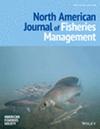通过在美国东南部运动钓鱼锦标赛上取样发现的鲯鳅体长的时间变化
IF 1.4
4区 农林科学
Q3 FISHERIES
引用次数: 0
摘要
目标我们的目标是利用体育钓鱼锦标赛数据来确定近几十年来北大西洋西部(WNA)鲯鳅(Coryphaena hippurus)的体型是否发生了变化。方法我们对北卡罗来纳州、南卡罗来纳州和佛罗里达州的海洋体育钓鱼锦标赛上岸的鲯鳅体长进行了采样。通过长度与年份的回归,分别拟合了雄性和雌性鲯鳅的长度数据的线性模型。这些模型的一个子集(协方差分析)将锦标赛作为一个因素考虑在内。结果协方差分析模型对每场锦标赛都有一个单独的回归斜率,这为雄性和雌性鲯鳅的数据提供了最佳拟合。在五次比赛中,有四次发现雌雄鲯鳅的体长出现有意义的时间性下降(第五次比赛未观察到体长变化)。预计雄鱼的总长度下降中位数分别为 168、105、103 和 426 毫米,雌鱼的总长度下降中位数分别为 354、133、131 和 246 毫米。在大多数比赛和特定性别的数据组合中,都发现鲯鳅最大体型的下降(置信区间为97.5%),这可能表明鲯鳅种群的捕捞死亡率过高。体型下降的原因可能是捕捞影响、环境影响或这些因素的综合作用。个体大小的减少可能与近期利用在 WNA 收集到的渔业数据进行的其他研究中发现的丰度下降同时发生。本文章由计算机程序翻译,如有差异,请以英文原文为准。
Temporal changes in lengths of Dolphinfish revealed by sampling at sportfishing tournaments in the southeastern United States
ObjectiveOur objective was to use sportfishing tournament data to determine whether sizes of Dolphinfish Coryphaena hippurus have been changing in the western North Atlantic (WNA) over recent decades.MethodsWe sampled North Carolina, South Carolina, and Florida marine sportfishing tournament landings for Dolphinfish lengths. Linear models were separately fitted to length data for males and females by regressing length against year. A subset of these models (analysis of covariance) considered tournament as a factor.ResultAn analysis of covariance model with a separate regression slope for each tournament provided the best fit to the data for male and female Dolphinfish. Meaningful temporal declines in the length of males and females were found for four of the five tournaments (no changes in length were observed for the fifth tournament). Median total length declines of 168, 105, 103, and 426 mm were predicted for males, and declines of 354, 133, 131, and 246 mm were predicted for females. Declines in the largest observed sizes of Dolphinfish (97.5% confidence limit) were found for most tournament‐ and sex‐specific combinations of data and could suggest excess fishing mortality on the population.ConclusionDeclines in Dolphinfish size in the WNA region could have ramifications for conservation of the population given that these size changes translate into reduced individual fecundity of female Dolphinfish. Causes of the size decline could be fishing effects, environmental effects, or a combination of these. Reductions in individual size may be occurring simultaneously with declines in abundance identified in other recent research using fishery‐dependent data collected in the WNA.
求助全文
通过发布文献求助,成功后即可免费获取论文全文。
去求助
来源期刊
CiteScore
2.60
自引率
18.20%
发文量
118
审稿时长
2 months
期刊介绍:
The North American Journal of Fisheries Management promotes communication among fishery managers with an emphasis on North America, and addresses the maintenance, enhancement, and allocation of fisheries resources. It chronicles the development of practical monitoring and management programs for finfish and exploitable shellfish in marine and freshwater environments.
Contributions relate to the management of fish populations, habitats, and users to protect and enhance fish and fishery resources for societal benefits. Case histories of successes, failures, and effects of fisheries programs help convey practical management experience to others.

 求助内容:
求助内容: 应助结果提醒方式:
应助结果提醒方式:


